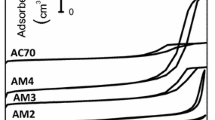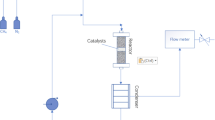Abstract
The study is devoted to the deactivation behavior of alumina “guard-type” mesoporous and hierarchical catalysts in long-term 800 h hydroprocessing of heavy oil under conditions close to industrial ones. The purely mesoporous sample had only 10–15 nm mesopores by Hg porosimetry whereas the hierarchical catalyst possessed a bimodal pore size distribution with maximum at 15 nm (55 vol%) and 40 nm (45 vol%, related to the mouths of 200 nm spherical macropores). Both catalysts had similar activities for the first 200 h of hydroprocessing. The mesoporous catalyst underwent the rapid deactivation in hydrodesulfurization (HDS) and hydrodemetallization (HDM) of V after 200 h on stream, and the remarkable decrease in hydrodeaspaltenization (HDAs) and Ni removal after 300–400 h on stream due to the intensive mesopore plugging by 55% of the total volume. The hierarchical catalyst did not show any decline in HDS and HDAs during the 800 h experiment, though its HDM activity also reduced due to the surface poisoning and coke deposition, albeit to a lesser extent. The intrinsic mesopores of the hierarchical alumina were shown to narrow down to 10 nm but did not experience substantial blocking observed for the mesoporous catalyst. Hierarchical texture seems not only to provide wide macro- and mesopores less prone to plugging by coke species, but to ensure effective transport of reaction products out of the small pores which prevents them from blockage.
Graphical Abstract





Similar content being viewed by others
References
Organization of the Petroleum Exporting Countries (2017) Annual statistical bulletin. Organization of the Petroleum Exporting Countries, Vienna
Ancheyta J, Alvarez-Majmutov A, Leyva C (2016) Hydrotreating of oil fractions. Multiphase catalytic reactors. Wiley, New York. pp 295–329
Castañeda LC, Muñoz JD, Ancheyta J (2014) Current situation of emerging technologies for upgrading of heavy oils. Catal Today 220–222:248–273. https://doi.org/10.1016/j.cattod.2013.05.016
Ancheyta J, Speight JG (2007) Hydroprocessing of heavy oils and residua. CRC Press, Boca Raton
Ancheyta J (2016) Deactivation of hydroprocessing catalysts. Deactivation of heavy oil hydroprocessing catalysts: fundamentals and modeling. Wiley, New York. pp 89–126
Baltus RE, Anderson JL (1983) Hindered diffusion of asphaltenes through microporous membranes. Chem Eng Sci 38:1959–1969
Chiang C-L, Tiou H-H (1992) Optimal design for the residual oil hydrodemetallation in a fixed bed reactor. Chem Eng Comm 117:383–399
Ruckenstein E, Tsai HC (1981) Optimum pore size for the catalytic conversion of large molecules. AIChE J 27:697–699
Shimura M, Shiroto Y, Takeuchi C (1986) Effect of Catalyst pore structure on hydrotreating of heavy oil. Ind Eng Chem Fundam 25:330–337. https://doi.org/10.1021/i100023a005
Leyva C, Ancheyta J, Mariey L et al (2014) Characterization study of NiMo/SiO2-Al2O3 spent hydroprocessing catalysts for heavy oils. Catal Today 220–222:89–96. https://doi.org/10.1016/j.cattod.2013.10.007
Liu ZY, Chen SL, Dong P, Ge XJ (2012) Diffusion of heavy oil in SiO2 model catalyst and FCC catalyst. Adv Mater Res 550–553:158–163. https://doi.org/10.4028/www.scientific.net/AMR.550-553.158
Guichard B, Gaulier F, Barbier J et al (2018) Asphaltenes diffusion/adsorption through catalyst alumina supports—influence on catalytic activity. Catal Today 305:49–57. https://doi.org/10.1016/j.cattod.2017.10.016
Rao SM, Coppens MO (2012) Increasing robustness against deactivation of nanoporous catalysts by introducing an optimized hierarchical pore network-application to hydrodemetalation. Chem Eng Sci 83:66–76
Dong Y, Xu Y, Zhang Y et al (2018) Synthesis of hierarchically structured alumina support with adjustable nanocrystalline aggregation towards efficient hydrodesulfurization. Appl Catal A Gen 559:30–39. https://doi.org/10.1016/j.apcata.2018.04.007
Dong Y, Chen Z, Xu Y et al (2017) Template-free synthesis of hierarchical meso-macroporous Γ-Al2O3 support: superior hydrodemetallization performance. Fuel Process Technol 168:65–73. https://doi.org/10.1016/j.fuproc.2017.08.034
Absi-Halabi M, Stanislaus A, Al-Mughni T et al (1995) Hydroprocessing of vacuum residues: relation between catalyst activity, deactivation and pore size distribution. Fuel 74:1211–1215. https://doi.org/10.1016/0016-2361(94)00042-P
Sane RC, Tsotsis TT, Webster IA, Ravi-Kumar VS (1992) Studies of asphaltene diffusion and structure and their implications for resid upgrading. Chem Eng Sci 47:2683–2688
Wang WP, Guin JA (1991) A comparison of unimodal and bimodal catalyst deactivation behavior in a model compound system with rapid coke deposition. Fuel Process Technol 28:149–166. https://doi.org/10.1016/0378-3820(91)90046-F
Khaleel A, Al-Mansouri S (2010) Meso-macroporous γ-alumina by template-free sol-gel synthesis: The effect of the solvent and acid catalyst on the microstructure and textural properties. Colloids Surfaces A Physicochem Eng Asp 369:272–280. https://doi.org/10.1016/j.colsurfa.2010.08.040
Yabuki M, Takahashi R, Sato S et al (2002) Silica–alumina catalysts prepared in sol–gel process of TEOS with organic additives. Phys Chem Chem Phys 4:4830–4837. https://doi.org/10.1039/b205645c
Stanislaus A, Al-Dolama K, Absi-Halabi M (2002) Preparation of a large pore alumina-based HDM catalyst by hydrothermal treatment and studies on pore enlargement mechanism. J Mol Catal A Chem 181:33–39. https://doi.org/10.1016/S1381-1169(01)00353-3
Li Y, Peng C, Li L, Rao P (2014) Self-assembled 3D hierarchically structured gamma alumina by hydrothermal method. J Am Ceram Soc 97:35–39. https://doi.org/10.1111/jace.12652
Dong Y, Yu X, Zhou Y et al (2018) Towards active macro-mesoporous hydrotreating catalysts: synthesis and assembly of mesoporous alumina microspheres. Catal Sci Technol 8:1892–1904. https://doi.org/10.1039/c7cy02621h
Dupin T, Lavina J, Poisson R (1993) Process for the preparation of alumina agglomerates. United States patent US
Mendoza-Nieto JA, Vera-Vallejo O, Escobar-Alarcón L et al (2013) Development of new trimetallic NiMoW catalysts supported on SBA-15 for deep hydrodesulfurization. Fuel 110:268–277. https://doi.org/10.1016/j.fuel.2012.07.057
Boahene PE, Soni KK, Dalai AK, Adjaye J (2011) Application of different pore diameter SBA-15 supports for heavy gas oil hydrotreatment using FeW catalyst. Appl Catal A Gen 402:31–40. https://doi.org/10.1016/j.apcata.2011.05.005
Ruud Snel (1988) Control of the porous structure of amorphous silica—alumina: V. The effect of compaction. Appl Catal 36:249–258
Trimm DL, Stanislaus A (1986) The control of pore size in alumina catalyst supports: a review. Appl Catal 21:215–238. https://doi.org/10.1016/S0166-9834(00)81356-1
López-Salinas E, E JG, Hernández-Cortez JG et al (2005) Long-term evaluation of NiMo/alumina–carbon black composite catalysts in hydroconversion of Mexican 538 °C + vacuum residue. Catal Today 109:69–75
Chen S-L, Dong P, Xu K et al (2007) Large pore heavy oil processing catalysts prepared using colloidal particles as templates. Catal Today 125:143–148
Su B-L, Sanchez C, Yang X-Y (2012) Hierarchically structured porous materials: from nanoscience to catalysis, separation, optics, energy, and life science. Wiley, New York
Li H, Sheng-Li C, Peng D (2009) Preparation, characterization and catalytic performance of novel macroporous catalysts for heavy oil hydrogenation. Ranliao Huaxue Xuebao 37:444–447
Zi L, Sheng C, Peng D (2012) Novel macroporous residua FCC catalysts. Fuel Chem Technol 40
Nguyen-Huy C, Shin EW (2016) Hierarchical macro-mesoporous Al2O3-supported NiK catalyst for steam catalytic cracking of vacuum residue. Fuel 169:1–6. https://doi.org/10.1016/j.fuel.2015.11.088
Liu Z, Dong P (2012) Preparation of macroporous catalysts and their performance in catalytic cracking of heavy oil. J Fuel Chem Technol 40:1092–1097
Han D, Li X, Zhang L et al (2012) Hierarchically ordered meso/macroporous γ-alumina for enhanced hydrodesulfurization performance. Microporous Mesoporous Mater 158:1–6. https://doi.org/10.1016/j.micromeso.2012.03.022
Semeykina VS, Malkovich EG, Bazaikin YV et al (2018) Optimal catalyst texture in macromolecule conversion: a computational and experimental study. Chem Eng Sci 188:1–10. https://doi.org/10.1016/j.ces.2018.05.005
Larichev YV, Martyanov ON (2018) The dynamics of asphaltene aggregates in heavy crude oils on a nanometer scale studied via small-angle X-ray scattering in situ. J Pet Sci Eng 165:575–580
Parkhomchuk EV, Semeykina VS, Sashkina KA et al (2016) Synthesis of polystyrene beads for hard-templating of three-dimensionally ordered macroporosity and hierarchical texture of adsorbents and catalysts. Top Catal. https://doi.org/10.1007/s11244-016-0719-3
Semeykina V, Parkhomchuk E, Polukhin A et al (2015) CoMoNi catalyst texture and surface properties in heavy oil processing. Part I: hierarchical macro/mesoporous alumina support. Ind Eng Chem Res 55:3535–3545. https://doi.org/10.1021/acs.iecr.5b04730
Yumoto M, Kukes SG, Klein MT, Gates BC (1996) Catalytic Hydroprocessing of Aromatic Compounds: Effects of Nickel and Vanadium Sulfide Deposits on Reactivities and Reaction Networks. Ind Eng Chem Res 35:3203–3209. https://doi.org/10.1021/ie960023f
Hubaut R (2007) Vanadium-based sulfides as hydrotreating catalysts. Appl Catal A Gen 322:121–128. https://doi.org/10.1016/j.apcata.2007.01.020
Acknowledgements
The work was carried out within the framework of the budget project АААА-А17-117041710077-4 for Boreskov Institute of Catalysis. The authors would like to thank S. V. Cherepanova, N. A. Rudina, T. Ya. Efimenko, V. A., L. N. Atamanova, N. N. Malyarchuk, Trunova, G. S. Lytvak for the characterization of the catalysts and Yu. V. Larichev, P. P. Dik, D. D. Uvarkina and D. O. Novikov for their help with the characterization of the feed and oil products.
Author information
Authors and Affiliations
Corresponding author
Ethics declarations
Conflict of interest
There are no conflicts to declare.
Additional information
Publisher’s Note
Springer Nature remains neutral with regard to jurisdictional claims in published maps and institutional affiliations.
Electronic supplementary material
Below is the link to the electronic supplementary material.
Rights and permissions
About this article
Cite this article
Semeykina, V.S., Polukhin, A.V., Lysikov, A.I. et al. Texture Evolution of Hard-Templated Hierarchically Porous Alumina Catalyst in Heavy Oil Hydroprocessing. Catal Lett 149, 513–521 (2019). https://doi.org/10.1007/s10562-018-2646-3
Received:
Accepted:
Published:
Issue Date:
DOI: https://doi.org/10.1007/s10562-018-2646-3




